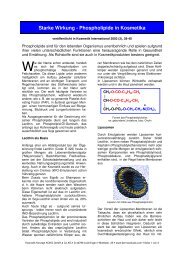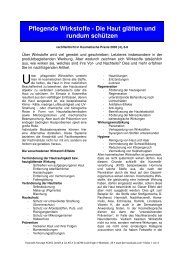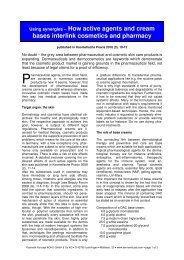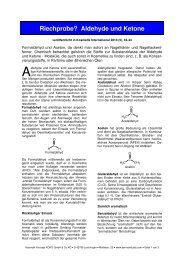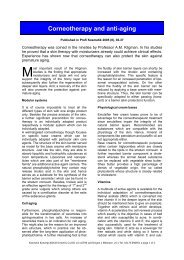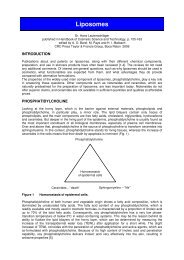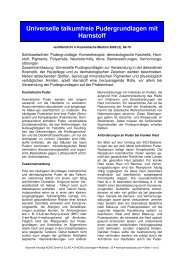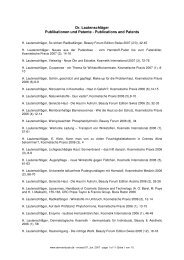Silicon â the global player in cosmetics - Dermaviduals
Silicon â the global player in cosmetics - Dermaviduals
Silicon â the global player in cosmetics - Dermaviduals
Create successful ePaper yourself
Turn your PDF publications into a flip-book with our unique Google optimized e-Paper software.
<strong>Silicon</strong> – <strong>the</strong> <strong>global</strong> <strong>player</strong> <strong>in</strong> <strong>cosmetics</strong><br />
published <strong>in</strong> Kosmetische Praxis 2010 (6), 12-15<br />
As a cosmetic agent, <strong>the</strong> element silicon plays a wallflower role: only at <strong>the</strong> first<br />
glance, though. As a matter of fact, <strong>the</strong> semi-metal is <strong>in</strong>significant as an active agent.<br />
However, organic silicon additives and <strong>in</strong>organic silicates are widely used <strong>in</strong> cosmetic<br />
products.<br />
S<br />
ilicon is a semi-metal and well-known as<br />
an essential component of chips and<br />
transistors. In Earth’s crust it is <strong>the</strong><br />
second most common element and can be<br />
found everywhere at our feet as sand, quartz<br />
or – <strong>in</strong> comb<strong>in</strong>ation with alum<strong>in</strong>um – <strong>in</strong> clay,<br />
mica and o<strong>the</strong>r rocks.<br />
Silicic acid & Co.<br />
When one burns (oxidizes) silicon, <strong>the</strong>n silicon<br />
dioxide (SiO 2) (or silica) will form which still<br />
today is used <strong>in</strong> some commercial abrasive<br />
hand cleans<strong>in</strong>g products to remove obst<strong>in</strong>ate<br />
dirt like tar, dyes or adhesives. These abrasive<br />
particles mostly are quartz particles (as e.g.<br />
sand from <strong>the</strong> seashores) which formerly were<br />
also applied <strong>in</strong> cosmetic peel<strong>in</strong>gs. S<strong>in</strong>ce quartz<br />
is a ra<strong>the</strong>r hard material, this specific cosmetic<br />
application has long s<strong>in</strong>ce become obsolete.<br />
The related silicic acid is a hydrated (water<br />
conta<strong>in</strong><strong>in</strong>g) silicon dioxide with completely<br />
different properties. The light powder with extensive<br />
surface is generally used as a separat<strong>in</strong>g<br />
agent for spice blends or table salt to<br />
<strong>in</strong>crease <strong>the</strong> pourability. Silicic acid concentrates<br />
<strong>in</strong> diatoms for <strong>in</strong>stance and is available<br />
on <strong>the</strong> market as diatomaceous earth (kieselgur).<br />
It braces <strong>the</strong> shoots of horsetail plants<br />
which <strong>in</strong> <strong>the</strong> German-speak<strong>in</strong>g area are also<br />
known as “pewter weed” as it formerly was<br />
used to polish <strong>the</strong> pewter ware. Horsetail extracts<br />
also conta<strong>in</strong> silicic acid and are used as<br />
additives <strong>in</strong> facial tonics and hair care products.<br />
Up to what extent <strong>the</strong> sales arguments<br />
that <strong>the</strong> product would streng<strong>the</strong>n sk<strong>in</strong>, nails<br />
and hair, can be associated with <strong>the</strong> silicic acid<br />
content rema<strong>in</strong>s a secret, though. Astr<strong>in</strong>gent<br />
horsetail extracts conta<strong>in</strong> fur<strong>the</strong>r <strong>in</strong>terest<strong>in</strong>g<br />
<strong>in</strong>gredients like sapon<strong>in</strong>es and flavonoids. It is<br />
worth remark<strong>in</strong>g that both connective tissue<br />
and skeleton depend on <strong>the</strong> <strong>in</strong>take of silicic<br />
acid. The human body conta<strong>in</strong>s about 20 mg<br />
silicic acid per kg at an average which is assimilated<br />
with <strong>the</strong> daily nutrition. The silicic acid<br />
content of beer made of barley and hops can<br />
be up to 50 mg silicon per liter.<br />
F<strong>in</strong>ely dispersed (colloidal) silicic acid – also<br />
known as aerosil – serves as a consistency<br />
agent for non-polar oils like paraff<strong>in</strong> oil. The<br />
results are oleogels (lipogels) which play a<br />
certa<strong>in</strong> part <strong>in</strong> pharmaceutical applications,<br />
however, are not accepted <strong>in</strong> <strong>the</strong> cosmetic field<br />
due to <strong>the</strong>ir <strong>in</strong>convenient haptic characteristics.<br />
An <strong>in</strong>terest<strong>in</strong>g fact is <strong>the</strong> absorb<strong>in</strong>g capacity of<br />
aerosil for oils, a property which allows transform<strong>in</strong>g<br />
oils <strong>in</strong>to powders – a technique which<br />
is also of <strong>in</strong>terest for process<strong>in</strong>g food.<br />
Silicic acid coated with titanium dioxide and<br />
iron oxide can be used <strong>in</strong> powders and makeup<br />
to m<strong>in</strong>imize <strong>the</strong> appearance of wr<strong>in</strong>kles.<br />
Those raw materials diffusely reflect <strong>the</strong> light,<br />
reduce <strong>the</strong> contrast<strong>in</strong>g effect of wr<strong>in</strong>kles and<br />
avoid a mask-like effect on <strong>the</strong> sk<strong>in</strong> due to <strong>the</strong>ir<br />
sk<strong>in</strong>-identical transparency. Generally, silicic<br />
acid is a frequent component of powders (INCI:<br />
Silica).<br />
Ano<strong>the</strong>r form of silicic acid is silica gel. It has<br />
a solid consistency and is offered <strong>in</strong> different<br />
gra<strong>in</strong> sizes. It is highly hygroscopic (waterabsorb<strong>in</strong>g)<br />
and hence serves as a desiccant <strong>in</strong><br />
laboratories. In <strong>the</strong> beauty <strong>in</strong>stitute, silica gel is<br />
used to transfer fresh flower fragrances <strong>in</strong>to<br />
sk<strong>in</strong> care oils by dry<strong>in</strong>g rose petals <strong>in</strong> <strong>the</strong> presence<br />
of oils and silica gel <strong>in</strong> a closed conta<strong>in</strong>er.<br />
Alum<strong>in</strong>osilicates<br />
In natural surround<strong>in</strong>gs, <strong>the</strong>re are various m<strong>in</strong>erals<br />
<strong>in</strong> which silicic acid is comb<strong>in</strong>ed with<br />
alum<strong>in</strong>um oxide: alum<strong>in</strong>osilicates. The alum<strong>in</strong>osilicate<br />
Kaol<strong>in</strong> (or ch<strong>in</strong>a clay) is used as a<br />
whiten<strong>in</strong>g pigment, as for <strong>in</strong>stance <strong>in</strong> <strong>the</strong><br />
manufactur<strong>in</strong>g of powders and make-up. Kaol<strong>in</strong><br />
forms with <strong>the</strong> decomposition process of<br />
feldspar. Feldspars are tectosilicates and, besides<br />
silicon and alum<strong>in</strong>um, <strong>the</strong>y also conta<strong>in</strong><br />
elements like sodium, potassium, calcium and<br />
barium.<br />
Micas belong to <strong>the</strong> scissile sheet silicates and<br />
are used <strong>in</strong> <strong>the</strong> field of decorative <strong>cosmetics</strong>.<br />
Micas have specific optical properties and,<br />
ground <strong>in</strong>to f<strong>in</strong>e powders, <strong>the</strong>y can be coated<br />
with various layers like silicic acid (see above).<br />
In comb<strong>in</strong>ation with quartz and feldspars <strong>the</strong>y<br />
form rocks like granite and gneiss which decompose<br />
<strong>in</strong>to clay <strong>in</strong> <strong>the</strong> course of time. Due<br />
to <strong>the</strong>ir expansive surface, clays and clayey<br />
Kosmetik Konzept KOKO GmbH & Co.KG • D-42799 Leichl<strong>in</strong>gen • Moltkestr. 25 • www.dermaviduals.com • page 1 of 4
<strong>Silicon</strong> – <strong>the</strong> <strong>global</strong> <strong>player</strong> <strong>in</strong> <strong>cosmetics</strong> page 2 of 4<br />
loams are processed <strong>in</strong>to heal<strong>in</strong>g earth (“Terra<br />
sana”). As components of cosmetic packs and<br />
masks <strong>the</strong>y absorb <strong>the</strong> body’s own substances<br />
and, on <strong>the</strong> o<strong>the</strong>r hand, <strong>the</strong>y release <strong>the</strong> added<br />
active agent components <strong>in</strong> a controlled way<br />
<strong>in</strong>to <strong>the</strong> sk<strong>in</strong>.<br />
Compared with <strong>the</strong> removal of cream masks<br />
and modelages, however, it is ra<strong>the</strong>r laborious<br />
to remove <strong>the</strong> clay after <strong>the</strong> treatment. An appropriate<br />
product <strong>in</strong> this context is <strong>the</strong> emulsifier-free<br />
cleans<strong>in</strong>g milk. Heal<strong>in</strong>g earths can be<br />
comb<strong>in</strong>ed with various physio<strong>the</strong>rapeutic treatments.<br />
The specific property of clay as ion exchanger<br />
is still more dist<strong>in</strong>ct <strong>in</strong> zeolites. On a<br />
limited scale <strong>the</strong>y even can be used as water<br />
softeners (phosphate replacement) or as an<br />
additive for bath<strong>in</strong>g products. The alum<strong>in</strong>osilicate<br />
bentonite absorbs enormous amounts<br />
of water and forms <strong>in</strong>organic, 5-10 %<br />
thixotropic gels. In comb<strong>in</strong>ation with pigments,<br />
glycols and oils, bentonite and analogous alum<strong>in</strong>osilicates<br />
even are appropriate <strong>in</strong>gredients<br />
for <strong>the</strong> manufactur<strong>in</strong>g of liquid make-ups.<br />
Talc<br />
The naturally occurr<strong>in</strong>g talc (soapstone) is a<br />
particularly soft <strong>in</strong>organic material. In powdered<br />
form it is called talcum, a magnesium<br />
silicate which feels like a lipid substance. It is a<br />
powder component and widely used <strong>in</strong> <strong>the</strong><br />
cosmetic field as it facilitates and enhances <strong>the</strong><br />
application of <strong>the</strong> powder. Fibrous talcum dusts<br />
<strong>in</strong>volve a certa<strong>in</strong> risk, though. Small particles of<br />
<strong>the</strong>se dusts may cause granulomas <strong>in</strong> <strong>the</strong> lung,<br />
similar to asbestos and, <strong>the</strong>y are not biologically<br />
degradable. Hence, <strong>the</strong> cosmetic market<br />
today cont<strong>in</strong>ues to promote talcum free powders.<br />
<strong>Silicon</strong>es<br />
In contrast to silicic acid and silicates, silicones<br />
are completely syn<strong>the</strong>tic substances. Actually,<br />
<strong>the</strong>ir chemical term is siloxanes respectively<br />
polysiloxanes as <strong>the</strong>y consist of shorter or<br />
longer subsequent silicon-oxygen units (-Si-O-<br />
Si-O-). Moreover, every silicon atom has two,<br />
and <strong>the</strong> first and last units of <strong>the</strong> cha<strong>in</strong> have<br />
three hydrocarbyls. If <strong>the</strong>se are two methyl<br />
groups we are deal<strong>in</strong>g with dimethicones<br />
(dimethylpolysiloxanes) which are widely used<br />
<strong>in</strong> <strong>the</strong> cosmetic <strong>in</strong>dustry.<br />
If <strong>the</strong> cha<strong>in</strong>s are r<strong>in</strong>g-like circular structures,<br />
<strong>the</strong>y are called cyclomethicones. Specific<br />
cyclic siloxanes are explicitly designated with<br />
<strong>the</strong> prefix cyclo and <strong>the</strong> suffix siloxane (as for<br />
<strong>in</strong>stance cyclotetrasiloxane).<br />
Methicones have only one methyl group at <strong>the</strong><br />
silicon atoms as well as ano<strong>the</strong>r hydrocarbyl<br />
which is explicitly listed <strong>in</strong> <strong>the</strong> INCI as an additive.<br />
Besides <strong>the</strong> relatively simple basic types <strong>the</strong>re<br />
is a multitude of o<strong>the</strong>r polysiloxanes. Instead of<br />
<strong>the</strong> methyl groups, <strong>the</strong>re are o<strong>the</strong>r hydrocarbyls<br />
as well as different functional groups located<br />
at <strong>the</strong> silicon atoms. Accord<strong>in</strong>gly, <strong>the</strong>re<br />
are multifarious fields of application. Ma<strong>in</strong>ly<br />
<strong>the</strong>ir hydrophobic and condition<strong>in</strong>g properties<br />
are utilized <strong>in</strong> <strong>the</strong> <strong>cosmetics</strong> field.<br />
There are volatile and liquid polysiloxanes<br />
which facilitate <strong>the</strong> application of <strong>the</strong> cosmetic<br />
products, and <strong>the</strong>re are highly molecular even<br />
wax-like representatives which rema<strong>in</strong> on <strong>the</strong><br />
sk<strong>in</strong> surface. The hydrophobic effect and simultaneously<br />
velvety feel<strong>in</strong>g <strong>in</strong> sk<strong>in</strong> care products<br />
is highly appreciated. The smoo<strong>the</strong>n<strong>in</strong>g<br />
and adhesive effect is used <strong>in</strong> cleans<strong>in</strong>g products<br />
and body lotions as for <strong>in</strong>stance for <strong>the</strong><br />
re-fatten<strong>in</strong>g of <strong>the</strong> sk<strong>in</strong>. The obviously agreeable<br />
feel<strong>in</strong>g on <strong>the</strong> sk<strong>in</strong> subjectively simulates<br />
a sk<strong>in</strong> recovery which objectively is non-existent.<br />
A broad field of application is given <strong>in</strong><br />
shampoos and hair condition<strong>in</strong>g products.<br />
A small selection of representatives is listed <strong>in</strong><br />
<strong>the</strong> follow<strong>in</strong>g whereas this list is not exhaustive:<br />
Dimethicone (INCI): These siloxanes occur <strong>in</strong><br />
a broad variety, from lower viscosity like water<br />
to higher viscosity, depend<strong>in</strong>g on <strong>the</strong>ir cha<strong>in</strong><br />
length. The most basic representative with<br />
def<strong>in</strong>ed cha<strong>in</strong> length is hexamethyldisiloxane<br />
(INCI) which has a boil<strong>in</strong>g po<strong>in</strong>t of 101°C and<br />
is as fluid as water, however, without its typical<br />
cool<strong>in</strong>g effect. The fluid and volatile compounds<br />
are spread<strong>in</strong>g and soften<strong>in</strong>g agents<br />
with low surface tension. They are frequently<br />
used <strong>in</strong> antiperspirants and deodorants and<br />
generally improve <strong>the</strong> combability of wet hair.<br />
The higher molecular, non-volatile representatives<br />
are frequently used <strong>in</strong> comb<strong>in</strong>ation with<br />
m<strong>in</strong>eral oils as lipid substances <strong>in</strong> creams as<br />
well as water-repellent sk<strong>in</strong> protection products.<br />
It is quite a disadvantage for <strong>the</strong> <strong>in</strong>dustrial<br />
sector that f<strong>in</strong>gerpr<strong>in</strong>ts orig<strong>in</strong>at<strong>in</strong>g from<br />
silicone-conta<strong>in</strong><strong>in</strong>g products are quite difficult<br />
to remove from <strong>the</strong> work pieces. That is <strong>the</strong><br />
reason why <strong>in</strong> this sector products often are<br />
promoted as “silicone free”. By <strong>the</strong> way, this<br />
also is a disadvantage <strong>in</strong> connection with hair<br />
products s<strong>in</strong>ce polysiloxanes may accumulate<br />
<strong>in</strong> <strong>the</strong> hairs with frequent use of shampoos or<br />
hair conditioners.<br />
Hexamethyldisiloxane (INCI)<br />
Kosmetik Konzept KOKO GmbH & Co.KG • D-42799 Leichl<strong>in</strong>gen • Moltkestr. 25 • www.dermaviduals.com • page 2 of 4
<strong>Silicon</strong> – <strong>the</strong> <strong>global</strong> <strong>player</strong> <strong>in</strong> <strong>cosmetics</strong> page 3 of 4<br />
Cyclomethicone (INCI): This term refers to<br />
differently sized non-def<strong>in</strong>ed dimethylpolysiloxane<br />
r<strong>in</strong>gs. The def<strong>in</strong>ed cyclopentasiloxane<br />
(INCI) consists of a 10-membered r<strong>in</strong>g and is<br />
used as spread<strong>in</strong>g agent for highly viscous<br />
silicone oils. The comb<strong>in</strong>ation allows treat<strong>in</strong>g<br />
hair ends and creat<strong>in</strong>g straight and sh<strong>in</strong>y hair.<br />
The combability of wet as well as dry hair is<br />
improved. The six-membered r<strong>in</strong>g of cyclotrisiloxane<br />
(INCI) and <strong>the</strong> 8-membered r<strong>in</strong>g of<br />
cyclotetrasiloxane (INCI) even have stronger<br />
spread<strong>in</strong>g properties. Like hexamethyldisiloxane<br />
<strong>the</strong>y are volatile. Cyclic siloxanes are<br />
conta<strong>in</strong>ed <strong>in</strong> lipsticks for <strong>in</strong>stance where <strong>the</strong>y<br />
replace part of <strong>the</strong> non-volatile hydrocarbons.<br />
Also deodorant sprays and aerosol products<br />
are equipped with <strong>the</strong>se substances.<br />
Alkyl Dimethicone is <strong>the</strong> generic term for dimethylpolysiloxanes<br />
with a methyl group on<br />
<strong>the</strong> silicon atom partly exchanged by a longer<br />
hydrocarbyl. Examples <strong>in</strong> this context are cetyl<br />
dimethicone, stearyl dimethicone, C24-28 alkyl<br />
dimethicone and C30-45 alkyl dimethicone. If a<br />
methyl group is completely exchanged <strong>the</strong>y are<br />
called alkyl methicone: hexyl methicone,<br />
stearyl methicone, cetearyl methicone, C30-45<br />
alkyl methicone. The mostly wax-like substances<br />
are <strong>in</strong>gredients of sk<strong>in</strong> care creams,<br />
sun protection and decorative cosmetic products<br />
as e.g. lipsticks, mascara as well as<br />
make-up. Long-cha<strong>in</strong>ed alkyl residues cause<br />
occlusive sk<strong>in</strong> conditions, similar to vasel<strong>in</strong>e.<br />
Polymerized v<strong>in</strong>yl dimethicone (INCI) forms<br />
wax gels whose viscosity can be adapted with<br />
low-molecular siloxanes. Vice versa, it is used<br />
as a consistency agent <strong>in</strong> sk<strong>in</strong> care creams.<br />
Phenyl Methicone (INCI): These compounds<br />
conta<strong>in</strong> a methyl and a phenyl group on <strong>the</strong>ir<br />
silicon atoms. Besides <strong>the</strong> condition<strong>in</strong>g properties<br />
<strong>the</strong>y also offer <strong>in</strong>terest<strong>in</strong>g optical characteristics<br />
as <strong>the</strong>y have <strong>the</strong> same refraction <strong>in</strong>dex<br />
as hair. They enhance both radiance and brilliance<br />
of <strong>the</strong> hair. On <strong>the</strong> o<strong>the</strong>r hand <strong>the</strong>y form<br />
slid<strong>in</strong>g films and create smooth hair.<br />
Hydroxypropyl dimethicone (INCI) belongs<br />
to <strong>the</strong> dimethyl polysiloxanes with partial, functionalized<br />
alkyl groups which affect <strong>the</strong> condition<strong>in</strong>g<br />
properties due to <strong>the</strong>ir <strong>in</strong>creased hydrophilicity.<br />
A fur<strong>the</strong>r addition of propylene oxide<br />
and ethylene oxide results <strong>in</strong> copolymers like<br />
PEG/PPG-25/25 dimethicone (INCI). They<br />
comb<strong>in</strong>e <strong>the</strong> emulsify<strong>in</strong>g pr<strong>in</strong>ciple of polyethylene<br />
glycols (PEG) respectively polypropylene<br />
glycols (PPG) with <strong>the</strong> condition<strong>in</strong>g characteristics<br />
of polysiloxanes. Hence, <strong>the</strong>re is no need<br />
for emulsifiers (“2 <strong>in</strong> 1”) or, <strong>the</strong>y serve as coemulsifiers<br />
and have anti-static effects. A<br />
common term for PEG copolymers with non-<br />
def<strong>in</strong>ed cha<strong>in</strong> length is dimethicone copolyol<br />
(INCI). In esterified form, as for <strong>in</strong>stance dimethicone<br />
copolyol behenate (INCI) <strong>the</strong>y are<br />
used as humectants and emollients. E<strong>the</strong>rs, as<br />
e.g. with natural substances like beeswax<br />
(INCI: dimethicone copolyol beeswax) are also<br />
possible.<br />
Dimethicone copolyol (INCI) and cyclomethicones<br />
are cleans<strong>in</strong>g product components as<br />
<strong>the</strong>y are able to dissolve lipophilic dirt particles.<br />
dimethicone copolyol supports a stable, thick<br />
foam and hence is applied <strong>in</strong> foam baths,<br />
shower gels and liquid soaps.<br />
Cationic polysiloxanes are water dispersible<br />
like <strong>the</strong> above mentioned PEG derivatives, due<br />
to <strong>the</strong> fact that <strong>the</strong> am<strong>in</strong>o groups conta<strong>in</strong>ed <strong>in</strong><br />
<strong>the</strong> alkyl residues, similar to quats, form salts<br />
when comb<strong>in</strong>ed with acids which adhere ra<strong>the</strong>r<br />
well to prote<strong>in</strong>s. Quaternium-80 (INCI) with its<br />
substantial hair coat<strong>in</strong>g features belongs to this<br />
substance group. Like <strong>the</strong> non-functional<br />
polysiloxanes, it improves <strong>the</strong> combability of<br />
wet and dry hair. It can be used to treat damaged<br />
hair ends. In comparison with <strong>the</strong> hydrophobic<br />
dimethyl polysiloxanes it is easier to<br />
remove with hair wash<strong>in</strong>g. Similar properties<br />
have am<strong>in</strong>opropyl dimethicone (INCI) and<br />
amodimethicone (INCI; ethylene diam<strong>in</strong>opropyl<br />
dimethicone). Amodimethicone hydroxystearate<br />
(INCI) is an example for a fatty acid<br />
salt. Also amides like stearamidopropyl dimethicone<br />
(INCI) are syn<strong>the</strong>tized from am<strong>in</strong>es<br />
and used as film<strong>in</strong>g agents and corrosion <strong>in</strong>hibitors.<br />
Dimethiconole (INCI) have Si-OH groups on<br />
<strong>the</strong>ir cha<strong>in</strong> ends whose polarity improves <strong>the</strong><br />
hair condition<strong>in</strong>g and anti-foam<strong>in</strong>g features. It<br />
should be mentioned at this po<strong>in</strong>t, that <strong>the</strong><br />
optimal solution frequently depends on a mixture<br />
of different polysiloxanes, specifically regard<strong>in</strong>g<br />
<strong>the</strong> hair care sector.<br />
The Si-OH group of <strong>the</strong> dimethiconole can be<br />
e<strong>the</strong>rified <strong>in</strong> turn; <strong>in</strong> this case stearoxy dimethicone<br />
(INCI) or behenoxy dimethicone (INCI)<br />
will form. The e<strong>the</strong>rs and esters as for <strong>in</strong>stance<br />
dimethicone stearate (INCI) and dimethicone<br />
behenate (INCI) are used as emollients <strong>in</strong> sk<strong>in</strong><br />
care products.<br />
F<strong>in</strong>ally, also <strong>the</strong> siliconized silicic acids, as<br />
e.g. silica dimethyl silylate (INCI) should be<br />
mentioned which is used as a consistency<br />
agent.<br />
Generally, silicones are highly tolerable substances<br />
and offer an almost universal field of<br />
application, i.e. <strong>the</strong> above mentioned examples<br />
only show part of <strong>the</strong> potential applications. On<br />
<strong>the</strong> o<strong>the</strong>r hand, however, <strong>the</strong>y are not com-<br />
Kosmetik Konzept KOKO GmbH & Co.KG • D-42799 Leichl<strong>in</strong>gen • Moltkestr. 25 • www.dermaviduals.com • page 3 of 4
<strong>Silicon</strong> – <strong>the</strong> <strong>global</strong> <strong>player</strong> <strong>in</strong> <strong>cosmetics</strong> page 4 of 4<br />
patible with natural <strong>cosmetics</strong> and physiological<br />
concepts. In terms of sk<strong>in</strong> sensation <strong>the</strong>y<br />
are well accepted, however, unlike physiological<br />
lipid substances <strong>the</strong>y do not support <strong>the</strong><br />
recovery of <strong>the</strong> sk<strong>in</strong>. In case of problem sk<strong>in</strong>s<br />
<strong>in</strong> <strong>the</strong> context of barrier and cornification disorders,<br />
<strong>the</strong> superficial feel<strong>in</strong>g on <strong>the</strong> sk<strong>in</strong> may be<br />
diametrically opposed to <strong>the</strong> actual sk<strong>in</strong> condition.<br />
Dr. Hans Lautenschläger<br />
Kosmetik Konzept KOKO GmbH & Co.KG • D-42799 Leichl<strong>in</strong>gen • Moltkestr. 25 • www.dermaviduals.com • page 4 of 4



